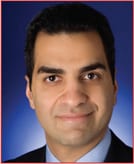An Executive Interview with Shahrokh Moinian, Head of Trade Finance and Cash Management Corporates Americas, Global Transaction Banking, Deutsche Bank, and Martin Runow, Head of Cash Management Corporates Americas, Global Transaction Banking, Deutsche Bank
What do you see as the most important cash and treasury management trends over the past 12-24 months for corporations headquartered or operating in North America?
 Shahrokh Moinian: Over the past 12-24 months, we have seen a return to a somewhat calmer, more stable business environment. Urgent concerns about the potential break-up of the euro have lessened and worries about bank counterparty risk have largely been alleviated. This return to more of a ‘business as usual’ environment has allowed treasurers to go back to core treasury issues such as efficiency, centralisation, automation and standardisation.
Shahrokh Moinian: Over the past 12-24 months, we have seen a return to a somewhat calmer, more stable business environment. Urgent concerns about the potential break-up of the euro have lessened and worries about bank counterparty risk have largely been alleviated. This return to more of a ‘business as usual’ environment has allowed treasurers to go back to core treasury issues such as efficiency, centralisation, automation and standardisation.
Centralisation, for example, has been a long-standing theme amongst treasurers, but in many cases, centralisation initiatives have been interrupted by the need to focus on managing liquidity and risk during challenging times. Over the past 12 months, treasurers have returned to centralisation projects, focusing on regions such as Asia. In the past, Asia has typically proved more complicated than North America or Europe with its diverse market, cultural, currency and regulatory landscape. Increasingly, however, treasurers are integrating their Asian businesses into payment factories and shared service centres (SSCs) and building out integrated ERP platforms.
Standardisation has also become more important, such as the wider use of XML ISO 20022 standards. Although these were originally developed for SEPA, banks and corporates alike recognise their global potential. Using SWIFT for corporate-to-bank connectivity also remains high on the corporate treasury agenda, allowing bank-agnostic communication through a single channel. Other initiatives too are also gaining traction, such as electronic bank account management (eBAM) which is now becoming a reality, again at a global level.
 Martin Runow: Technology investment is becoming more important amongst North American multinationals to achieve their efficiency, centralisation, automation and standardisation objectives. For example, we are seeing an increased focus on rolling out ERP platforms globally, closer integration between treasury and the wider business and greater depth of functionality to support core treasury requirements. These initiatives are illustrative of treasury’s elevated profile within the organisation and its interconnectivity with the wider business. Technology is also bringing a range of new opportunities of which treasurers are keen to take advantage. SEPA, for example, is proving a catalyst for initiatives such as virtual accounts that enable higher straight-through reconciliation rates.
Martin Runow: Technology investment is becoming more important amongst North American multinationals to achieve their efficiency, centralisation, automation and standardisation objectives. For example, we are seeing an increased focus on rolling out ERP platforms globally, closer integration between treasury and the wider business and greater depth of functionality to support core treasury requirements. These initiatives are illustrative of treasury’s elevated profile within the organisation and its interconnectivity with the wider business. Technology is also bringing a range of new opportunities of which treasurers are keen to take advantage. SEPA, for example, is proving a catalyst for initiatives such as virtual accounts that enable higher straight-through reconciliation rates.
Sign up for free to read the full article
Register Login with LinkedInAlready have an account?
Login
Download our Free Treasury App for mobile and tablet to read articles – no log in required.
Download Version Download Version





























